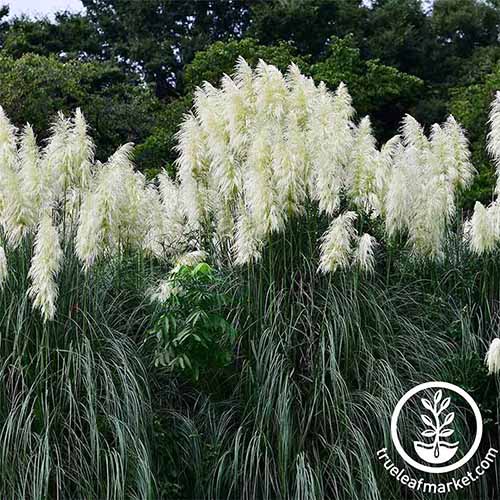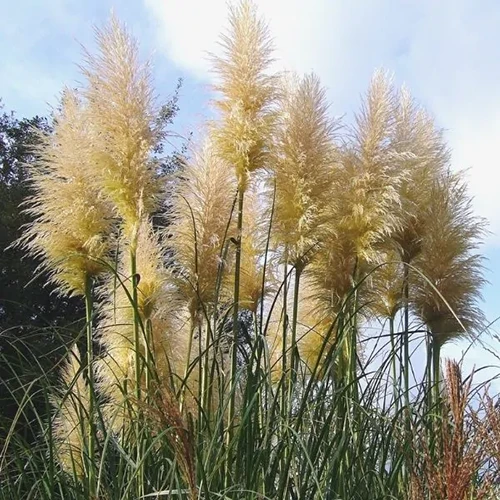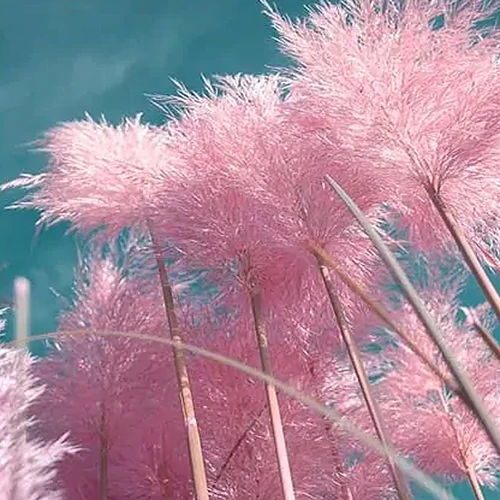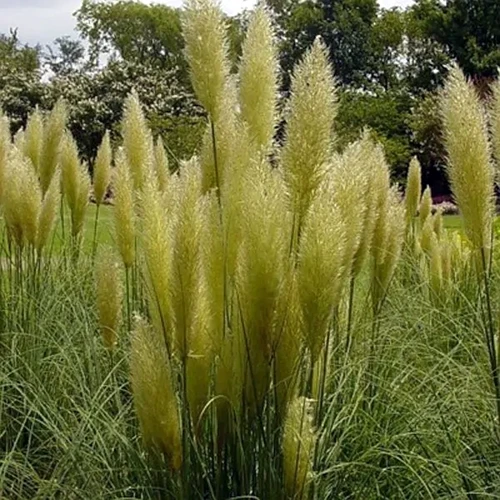Cortaderia selloana
When you spot its ethereal plumes swaying in the wind, it’s clear why pampas grass has rocketed to the top of everyone’s wish list.
I nearly passed out when I saw how much a couple of dried stalks cost at my local design store, especially given that it can be an invasive weed in some areas.
But in other places, it’s a tough, maintenance-free grass that looks far more delicate than it actually is.
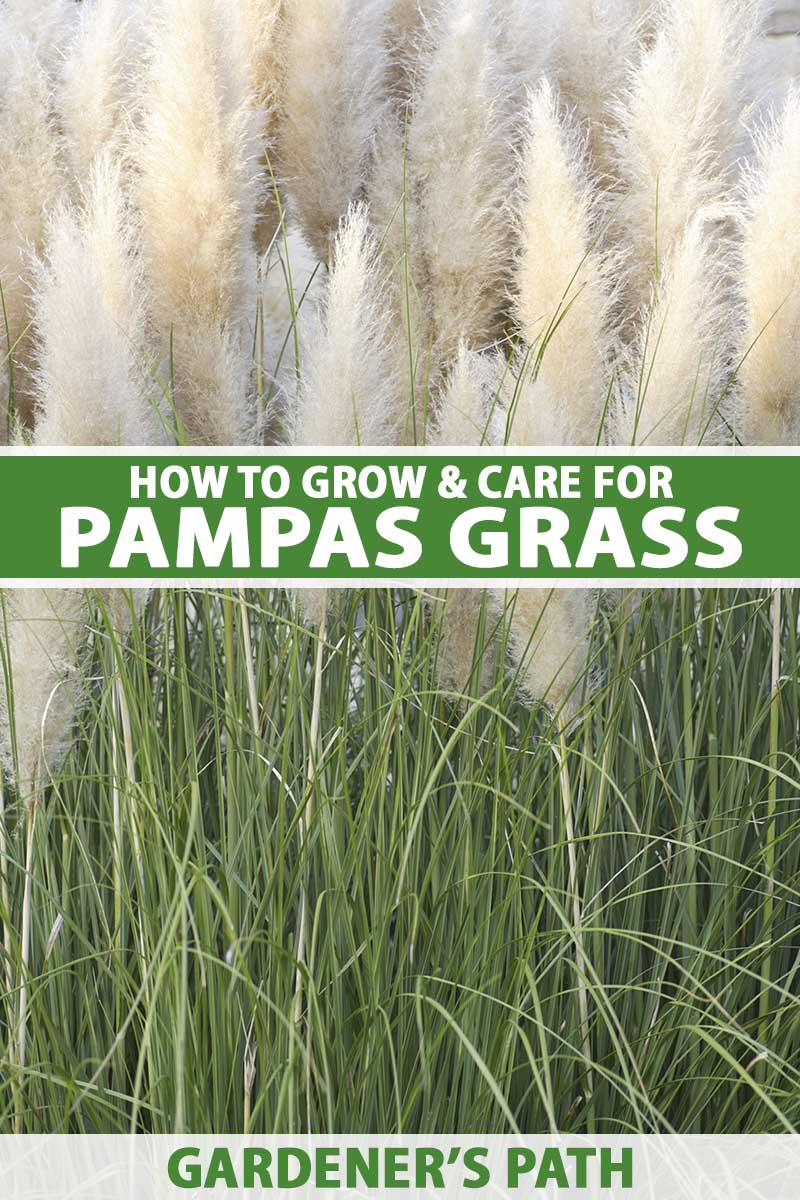
We link to vendors to help you find relevant products. If you buy from one of our links, we may earn a commission.
Propagate seed, or buy one (or a dozen) of the white, cream, silver, or pink cultivars in pots ready for transplanting to add a big, bold focal point or backdrop to your garden.
In the fall, snip them by the handful and bring them into your home for an of-the-moment interior design element.
Okay, enough chitchat. Let’s cover how to get this ornamental grass into your garden ASAP. Here’s what you can expect in the coming guide:
What You’ll Learn
The species is hardy in USDA Hardiness Zone 7 through 10, but there are lots of cultivars that will survive conditions in Zone 6 and up.
Cultivation and History
Pampas grass (Cortaderia selloana) is native to Argentina, Brazil, and Chile. But its elegant form and tough nature has attracted people to it across the globe.
The plants are made up of clumps of stems and leaves. These large clumps are called tussocks.
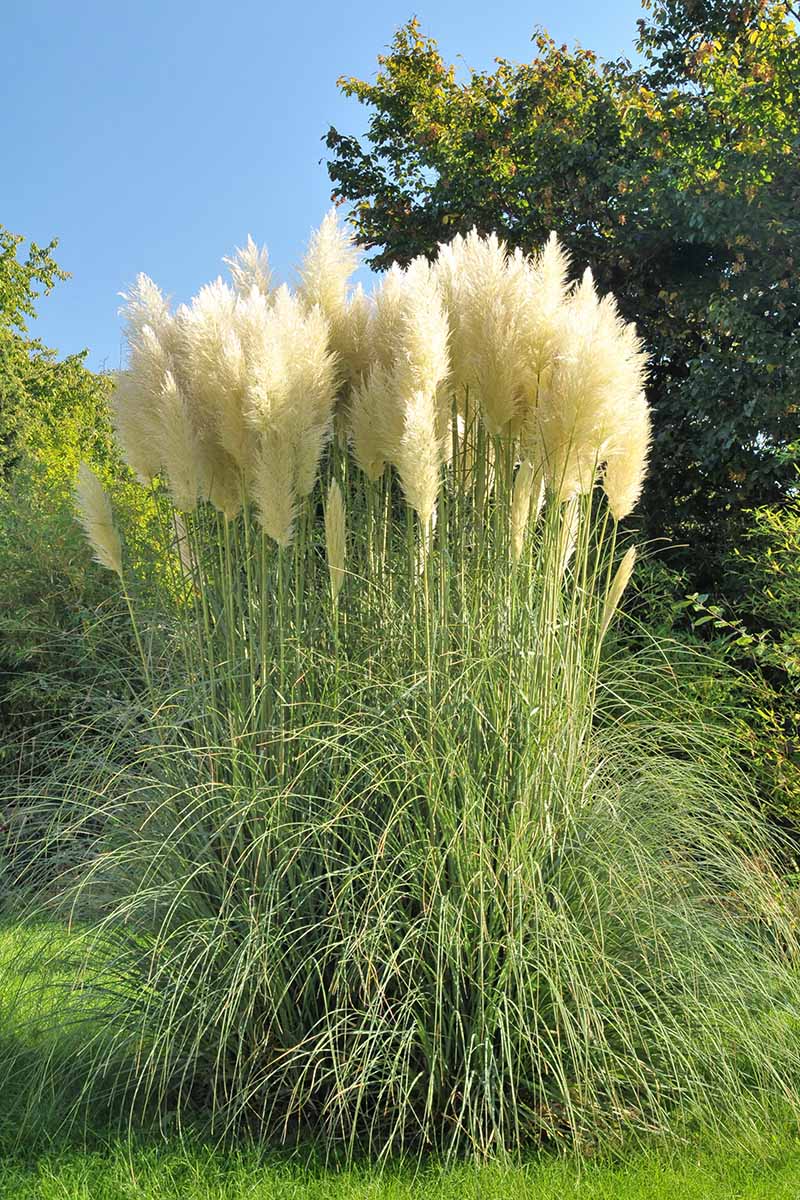
Each tussock is composed of long, narrow leaves that grow about six feet tall. The leaves are blue-green, long, and strappy, with toothed edges.
From the tussock of leaves emerge long, stiff stems, technically known as culms, that grow up to 13 feet tall. A single plant can stretch out beyond 10 feet.
At the end of the stem tips is where the magic happens. This is where the violet, pink, silver, cream, gray, or white flowers form. These inflorescences are called plumes, and they can grow up to three feet long.
Each flower is covered in long, silky hairs, giving the plumes that characteristic look that people love so much.
Eventually, small, dry, single-seeded fruits form. A single plant can produce hundreds of thousands of seeds. These seeds are extremely light and can be spread by wind, animals, or human activity.
Plants either have female flowers or hermaphroditic flowers, which are functionally male and pollinate the female flowers. In order to develop seeds, the female must have a hermaphroditic plant nearby.
The hermaphroditic plants don’t have silky hairs, so they’re less attractive to growers, but they also won’t spread seed, so they’re more easily controlled.
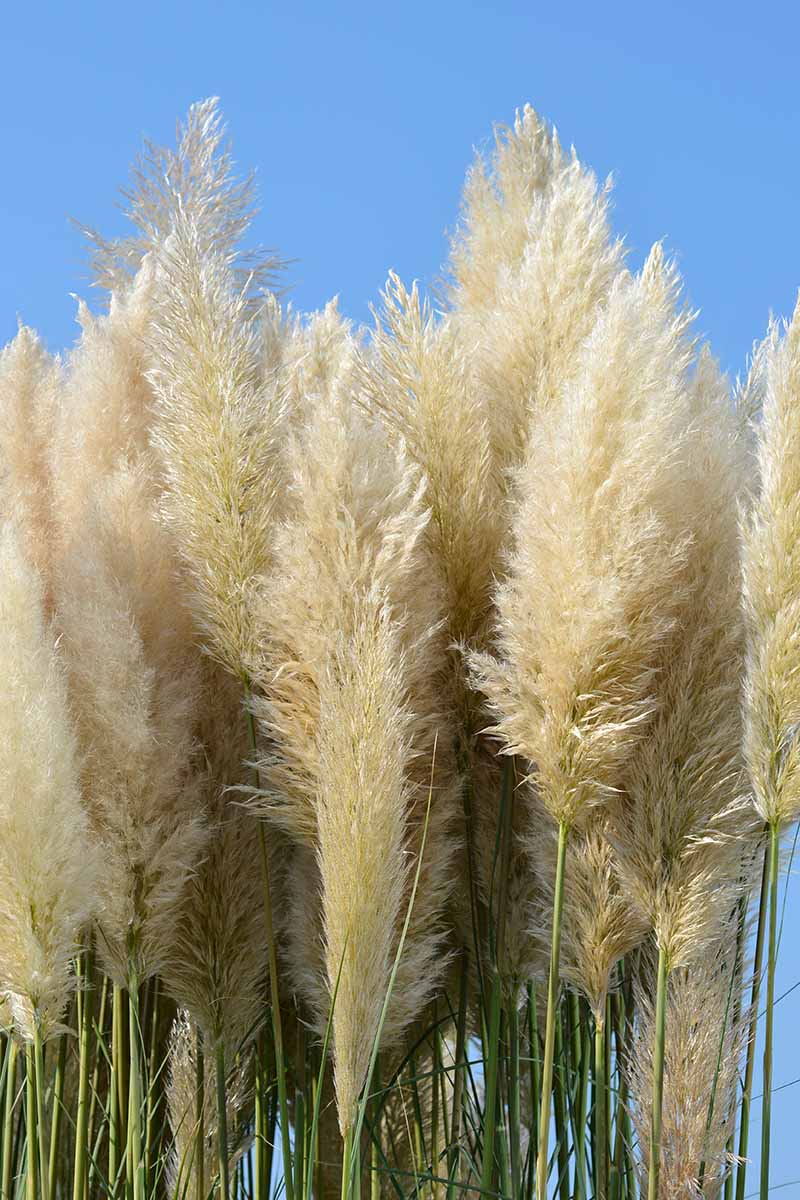
Before you go tossing tons of pampas grass out into your garden with dreams of the elegant seed heads swaying in the wind, be aware that this plant isn’t welcome in some places.
It’s considered invasive in California and Hawaii, and classified as a noxious weed in Washington and Oregon.
My neighbor couldn’t live without her pampas grass, so she planted some in a huge pot surrounded by a concrete patio on all sides, assuming she wouldn’t have to worry about any escape attempts.
I always chat with her when I walk by as she diligently pulls out the escapees that have taken hold in her garden.
Its close relative jubata (C. jubata) is also considered a noxious weed on the West Coast.
Both have naturalized in pastures, scrubland, disturbed areas, forests, coastal land, and shrublands.
If you live on the West Coast and decide that you don’t want to plant pampas grass after all, consider the similar-looking native alternative, giant wild rye (Elymus condensatus).
Pampas Grass Propagation
Pampas grass is easy to reproduce. Almost too easy. You’ll probably need to make more of an effort to limit its spread than to move it to new places.
Here are the three simple ways to propagate it:
From Seed
To grow pampas grass from seed, you could just wait for an existing plant to set seed heads and call it a day.
To grow it from seed in a specific location where you actually want it to grow, you can either buy seeds or harvest some from existing plants.
If you want to have a measure of control over how the new plants look, it’s best to purchase your seeds.
True Leaf Market carries 1,000 seeds of the white or pink plume options.
If you opt to harvest seeds, wait until the late summer or fall after the plumes have matured.
The plumes will have started to spread and shed, and the seeds will feel hard if you press them with your fingernail.
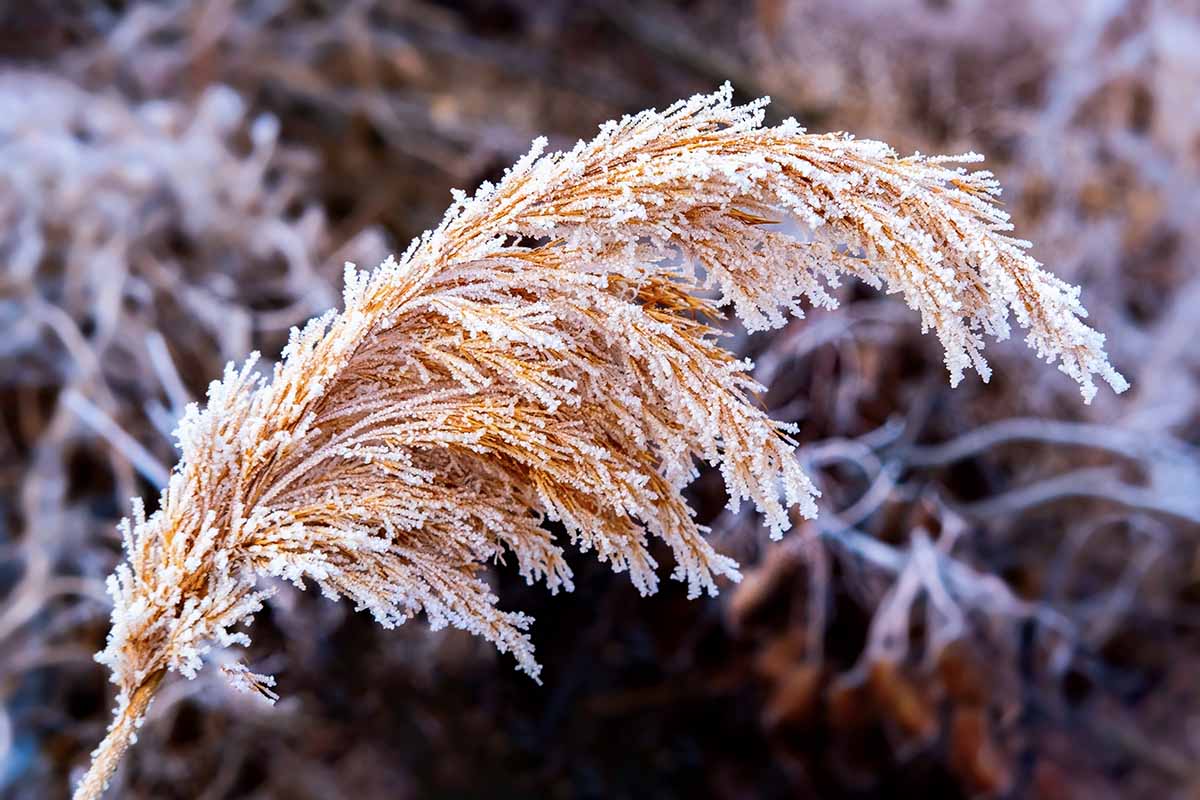
Gather the plumes and shake them over a large bowl. Blow on the seeds to remove the waste. Place the seeds in an envelope and keep them in a cool, dark location until late winter or early spring.
About 10 weeks before the last predicted frost date, place a few seeds in a five-inch pot filled with potting soil. Press the seeds just below the surface of the soil, about an eighth of an inch deep.
Water well with a spray bottle to avoid disturbing the soil. Keep the soil as moist as a sponge that you’ve wrung out really well.
Place in a window that receives about six hours of sunlight a day, or under grow lights for at least six hours a day.
The seeds don’t need light to germinate, but you want the light to be there once they pop up out of the soil in about two weeks.
Once the last predicted frost date has passed, move the seedlings outdoors gradually with a week-long hardening off period.
Take the pots outside for an hour and place them in a protected area with direct light. The next day, take the seedlings out for two hours. Keep adding an hour each day for a full week.
Now you can plant them in the ground or into an outdoor container.
From Divisions
Division should be done in the spring after new growth has emerged.
Before you get to work, don some long, thick gloves. You might not notice it when admiring them from afar, but the leaves are extremely sharp.
Seriously, you could practically use them in a pinch if you forget your knives on a picnic. You don’t want to slice your skin while you’re trying to expand your garden.
Cut back the section that you’re going to remove to just a few inches above the ground.
Use a shovel to dig up a pruned clump of the plant. I find it easiest to start at the outside and then dig around toward the middle.
Stick the shovel directly down once you reach the interior of the plant to wedge it apart.
Lift up the clump and move it to its new spot. Fill in the area where you removed the division with some soil.
Transplanting
To plant your seedlings, divisions, or purchased transplants, the first step is to go dig a hole the size of the plant or a bit wider.
There’s no need to amend the soil when planting pampas grass, but you can always work some aged compost into the removed soil if you want.
Remove the plant from the container and place it in the hole so that it sits at the same level as it was in the growing container. Fill back in around it with the removed soil.
Water to settle the soil and add more if needed.
How to Grow Pampas Grass
Do you have a patch of ground that receives more than six hours of sun per day and isn’t soggy? Great, that’s all you need to grow pampas grass.
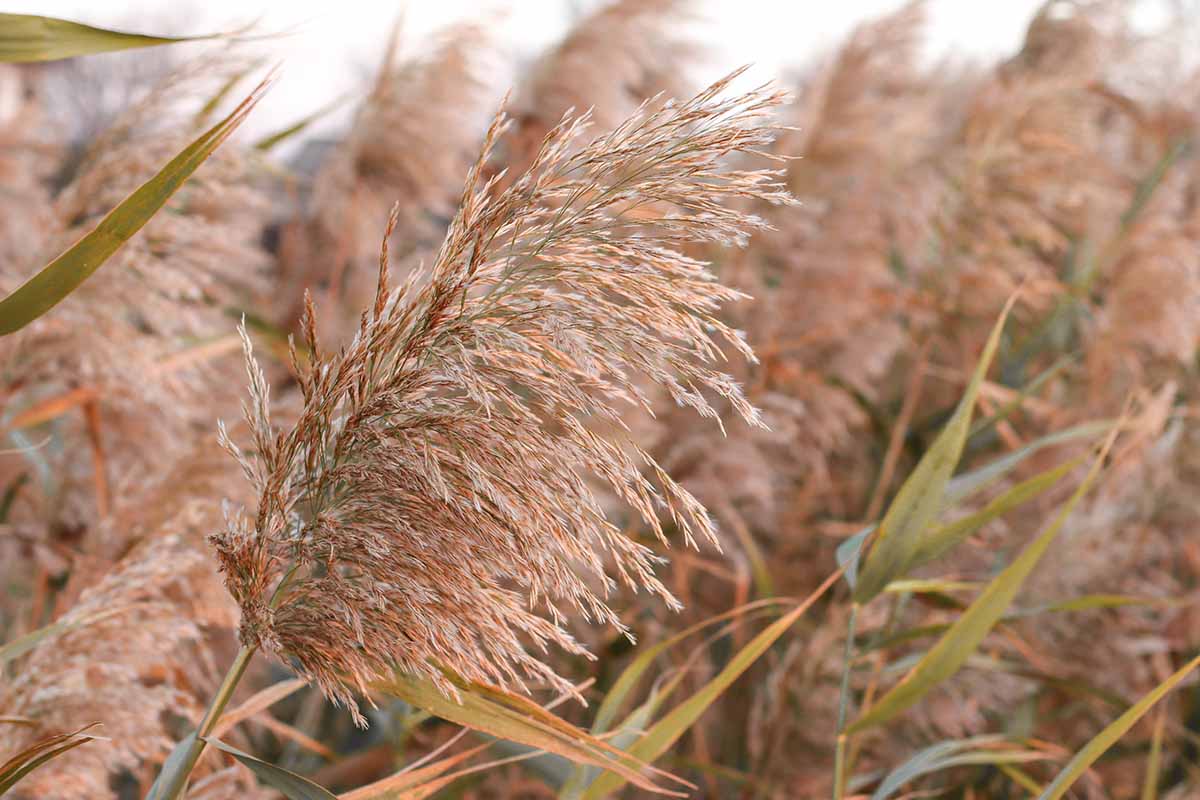
Heavy clay is fine, but only if you don’t receive a ton of rain. Constantly wet roots will cause rot.
Sandy or loamy soil with a pH of 6.0 to 7.5 is best.
This plant is drought tolerant, but depending on how dry your environment is, you might want to give it some supplemental water during long stretches of heat and dryness.
If you stick your finger into the ground, it should feel dry all the way down before you water again.
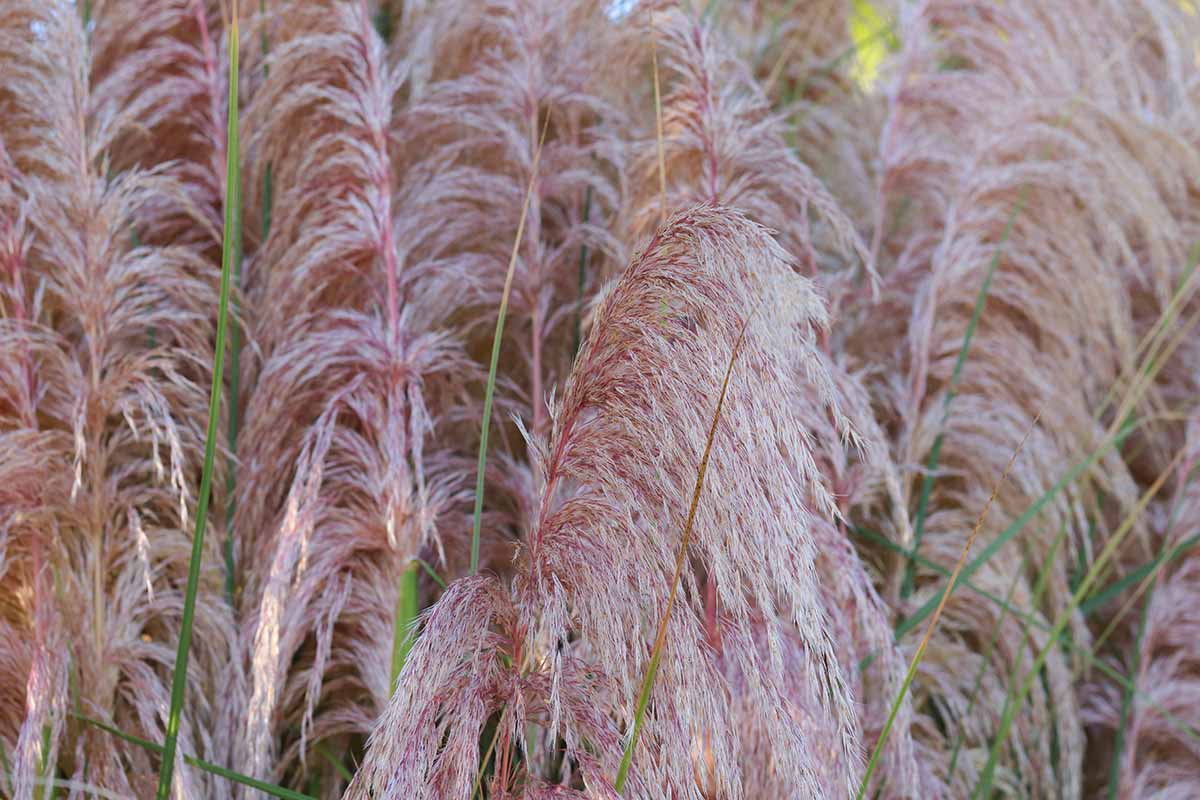
You don’t need to feed your plants, but I know a lot of us can’t resist. If you just can’t help but give it a boost, side-dress with well-rotted manure or compost once in the spring. Don’t feed after midsummer.
Don’t plant too close to your house or other outbuildings. When the pampas grass dries up in the fall, it becomes a fire hazard.
If you live in an area where pampas grass can be too enthusiastic, grow it in a container to (somewhat) limit its spread.
The roots grow deep, up to 12 feet into the ground, so choose a container that is deeper than it is wide. Something two feet in diameter and at least three feet deep is a good start.
Growing Tips
- Provide at least six hours of sun and dry soil.
- Don’t plant near buildings in dry areas as pampas grass becomes a fire hazard in the fall.
- Plant in a large container to help limit spread.
Maintenance
In locations where the temperatures drop below freezing regularly, pampas grass will die back to the ground in the winter.
Leave the stems in place throughout the winter, not only for the pretty addition they make to the landscape, but because we’ll just want to prune again in the spring anyway after the plant loses its stems during the winter.
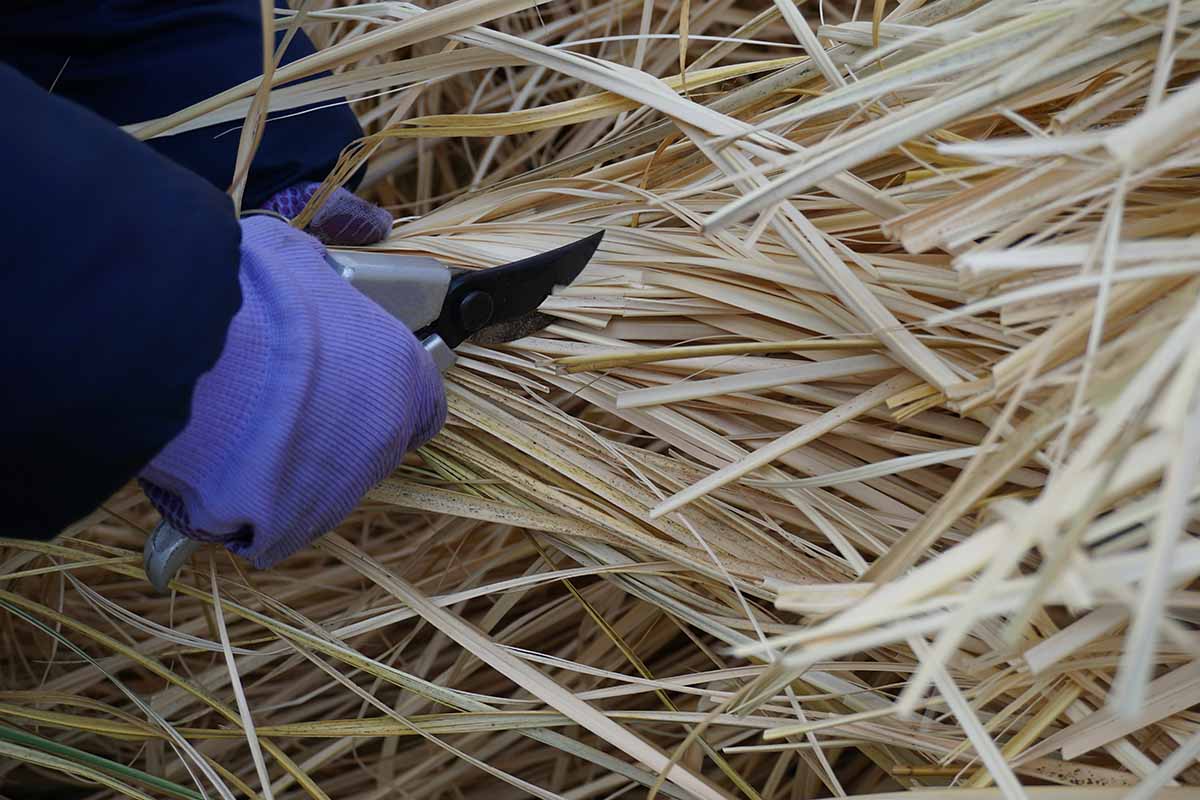
Refresh the clump by cutting the blades back in early spring to about an inch above the ground.
Visit our guide to pruning ornamental grasses for tips.
If you live somewhere warmer, the plant will remain evergreen. Tidy it up by raking out any dead material in the spring.
At a certain point, usually as the plant reaches the end of its life cycle of around 10 years, the center of the clump will begin to thin out, or it won’t produce seed heads.
That means it’s time to divide your pampas grass as described above.
If you live in Zone 6 or 7, it’s a good idea to protect the crowns during the winter with a heap of leaf mulch or pine mulch. Clean this away in the spring.
Pampas Grass Cultivars to Select
Growers have developed many different cultivars with brighter, larger flowers, a more compact growth habit, or greater cold tolerance. But there’s absolutely nothing wrong with the original.
If you want to pick up the species pampas grass, Nature Hills Nursery carries it in quart or #1 container sizes.
Here are some beautiful cultivars to choose from:
Andes Silver
The plumes on ‘Andes Silver’ have a striking silver hue that will positively stand out among the rest of the greens and typical colors in the garden.
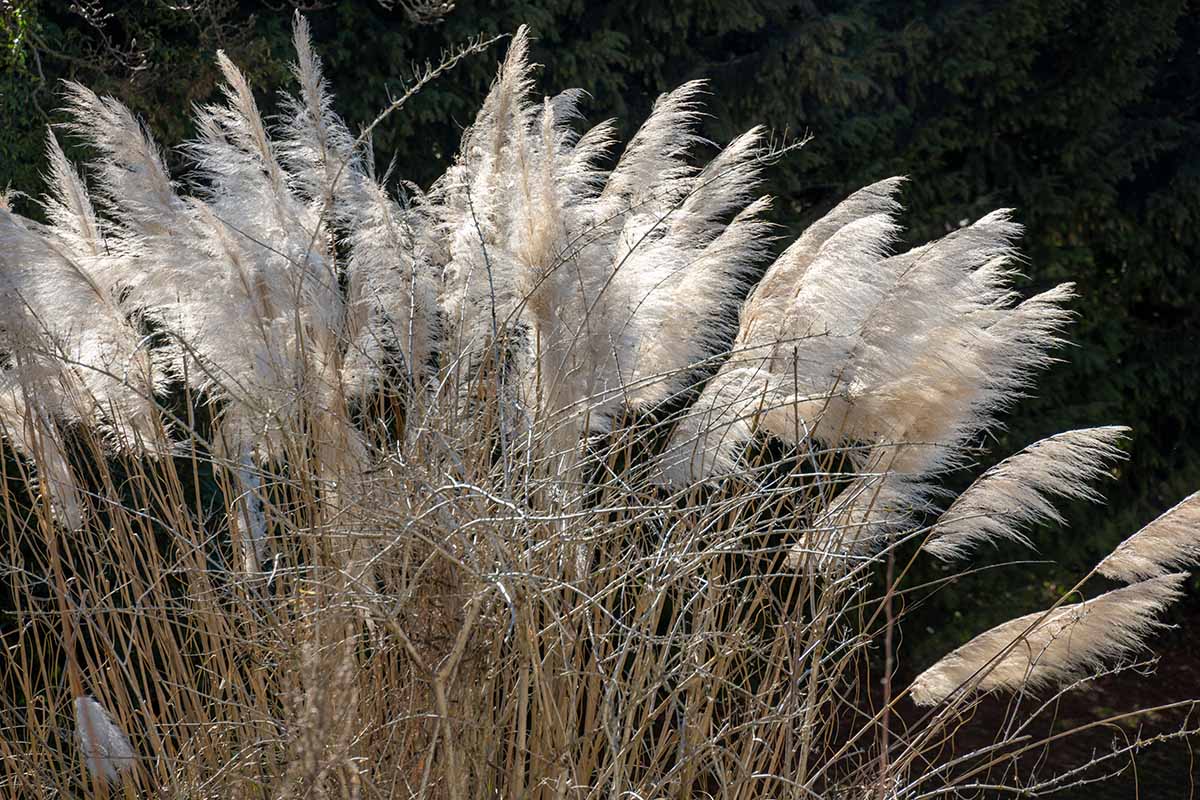
The plant grows up to seven feet tall and five feet wide. Those in Zones 6 can enjoy this variety, but be sure to provide the crown some protection in the winter.
Pink
Gorgeous C. selloana ‘Rosea’ is highly sought after, and it doesn’t take more than a quick glance to understand why. Just look at the huge, fairy-tale pink plumes.
Harvest them to use indoors, thereby preventing it from reseeding everywhere, and allowing you to enjoy the endless display.
This pink pampas grass doesn’t spread as wide as the species either, staying about half as wide. Pop on over to Nature Hills Nursery to pick up a plant.
Pumila
As we’ve discussed, pampas grass can take up a lot of space. But a dwarf one like ‘Pumila’ can fit into a smaller spot.
Of course, “dwarf” is a relative term, since this cultivar still grows up to five feet tall and about four feet wide. And the plumes are every bit as large as they are on the species plant.
This type is also sterile, so you don’t have to worry about the seed escaping into the neighbor’s yard, and it can withstand cold temperatures all the way down to Zone 6.
Bring one home from Nature Hills Nursery.
Managing Pests and Disease
Grasses are generally problem-free, and pampas grass is particularly tough.
Deer absolutely won’t touch the stuff, probably because they don’t want to get their mouths torn to pieces. Smaller mammals like mice might make a home in the base of the clump, but they don’t eat it.
Rarely, you’ll run into aphids and spider mites, particularly when it’s dry and hot out.
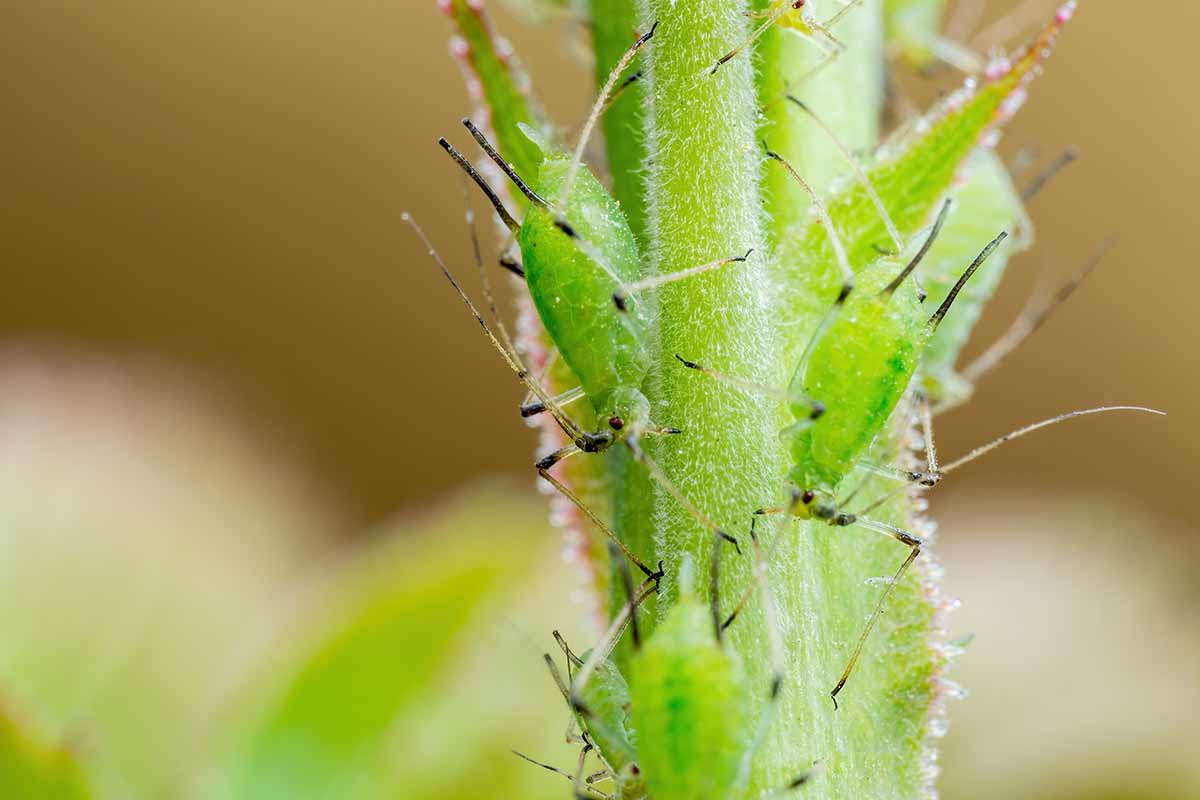
Both can usually be dealt with by spraying the plant with a strong blast of water to knock the bugs loose and away from your grass.
More advanced cases call for treatment with neem oil or insecticidal soap.
Pampas grass is pretty much immune to disease. You might bump up against root rot if you grow your plants in an area with poor drainage or standing water, but in this case, it’s simply caused by the roots drowning and not being able to access oxygen, not thanks to infection with a pathogen.
The above-ground parts will turn yellow and collapse. Underground, the roots turn into a black, mushy mess.
If you catch it early, you can address the cause by moving the plant to a better spot or being more parsimonious in your watering habits.
Best Uses of Pampas Grass
Whether as a specimen in the garden or in a container, this plant makes a big, bold splash.
It will draw all eyes with its elegant plumes, and it’s an excellent plant for erosion control as well. The cut plumes provide an elegant design element.
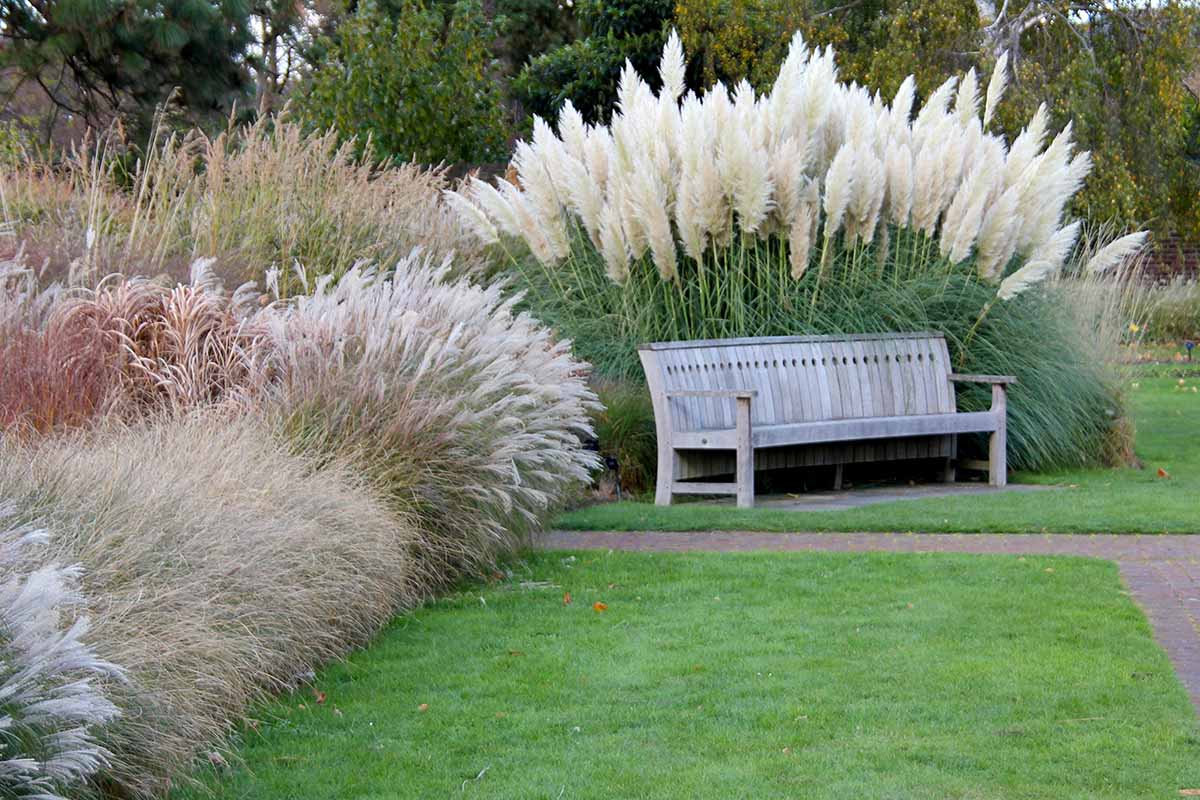
A single plant will make a statement, but plant it in groups for an even more impressive display. Imagine a whole mass of pampas grass lined up as a tall border plant.
Or one stately plant in the middle of colorful clumps of heliopsis, sedums, buddleia, zinnias, geraniums, or cosmos.
If you want to cut and use the flowers in arrangements, cut them before they’re fully mature and start to shed.
Hang them upside down and spray them with an art fixative or hairspray to extend the display. Dried plumes can last for years this way.
Quick Reference Growing Guide
| Plant Type: | Perennial grass | Flower/Foliage Color: | Cream, gray, pink, silver, violet or white/green, silver |
| Native to: | Argentina, Brazil, Chile | Water Needs: | Low |
| Hardiness (USDA Zones): | 6-10 | Maintenance: | Low |
| Bloom Time/Season: | Summer, fall | Tolerance: | Salt, freezing temperatures, drought |
| Exposure: | Full to partial sun | Soil Type: | Clay to loam |
| Time to Maturity: | 4 years | Soil pH: | 6.0-7.5 |
| Spacing: | 3 feet | Soil Drainage: | Well-draining |
| Planting Depth: | 1/8 inch (seeds), same depth as pot (transplants) | Attracts: | Pollinators, rodents |
| Height: | 13 feet | Companion Planting: | Buddleia, cosmos, geraniums, heliopsis, sedum, zinnias |
| Spread: | 10 feet | Family: | Poaceae |
| Growth Rate: | Fast | Genus: | Cortaderia |
| Common Pests and Diseases: | Aphids, spider mites; root rot | Species: | Selloana |
Ethereal, Elegant, and Surprisingly Tough
I’m not above planting something that I fell in love with when I saw it in the pages of a magazine, but sometimes these plants can prove to be a bigger challenge than I was prepared for.
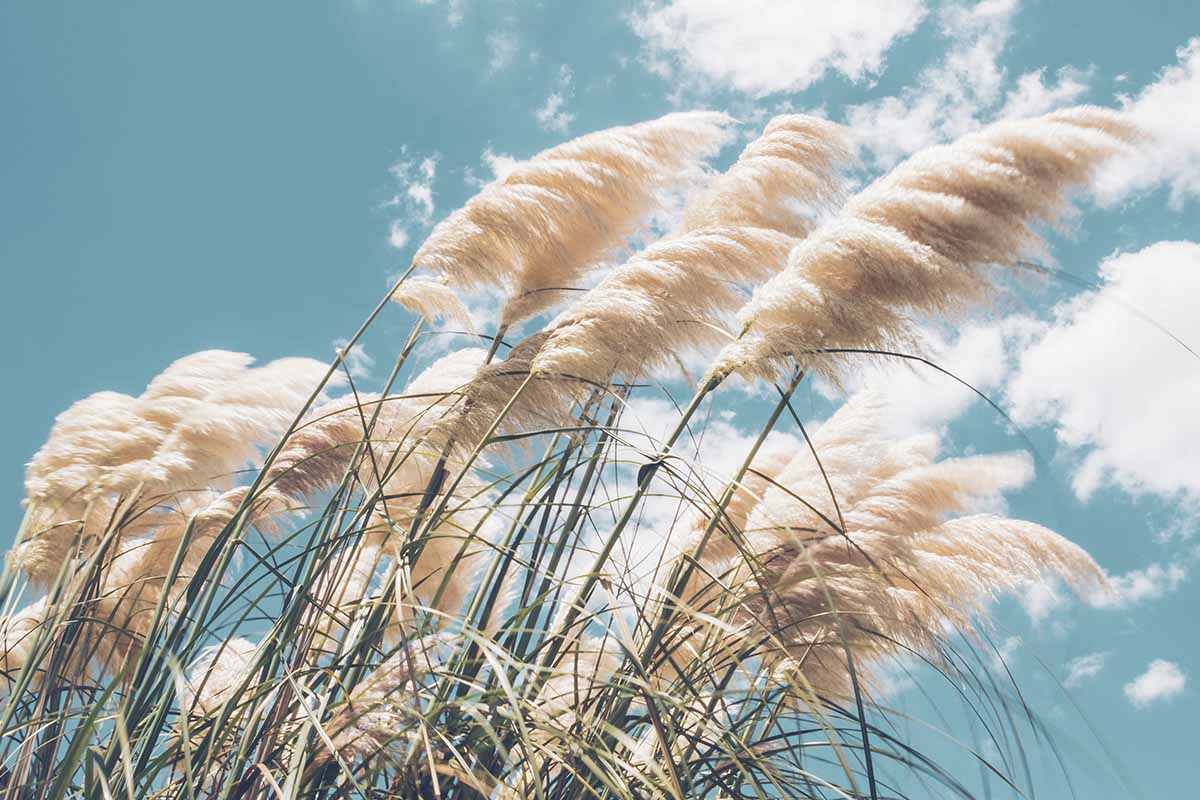
With pampas grass, you get the elegant, feather-like plumes with hardly any work on your part. It’s truly a set-it-and-forget-it kind of plant.
How do you plan to use your plumes? Are you going to plant yours in a container on your patio? Line them up in a row against a fence? Share your plans in the comments.
While it’s certainly one of the most notable grasses, it isn’t the only one. If you’d like to add some other ornamental grasses to your garden, pop on over to these guides next:
